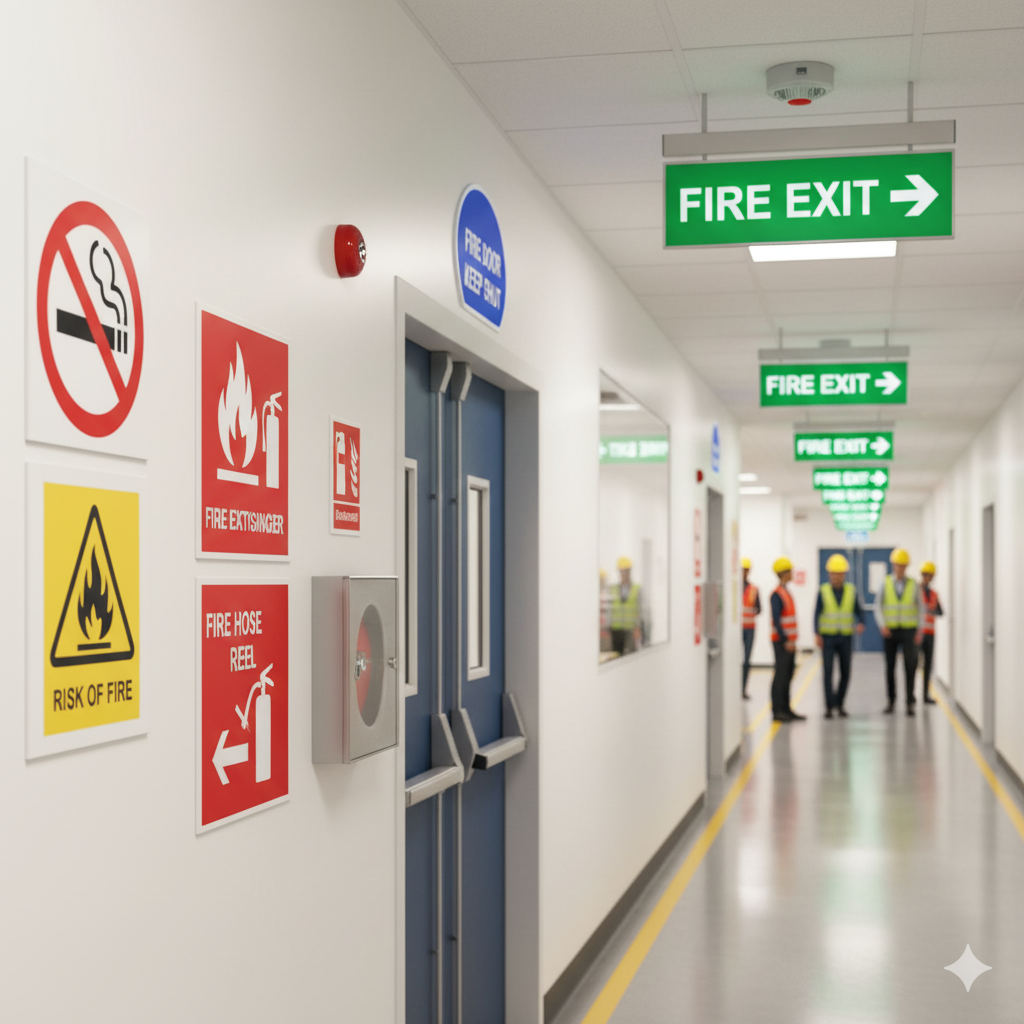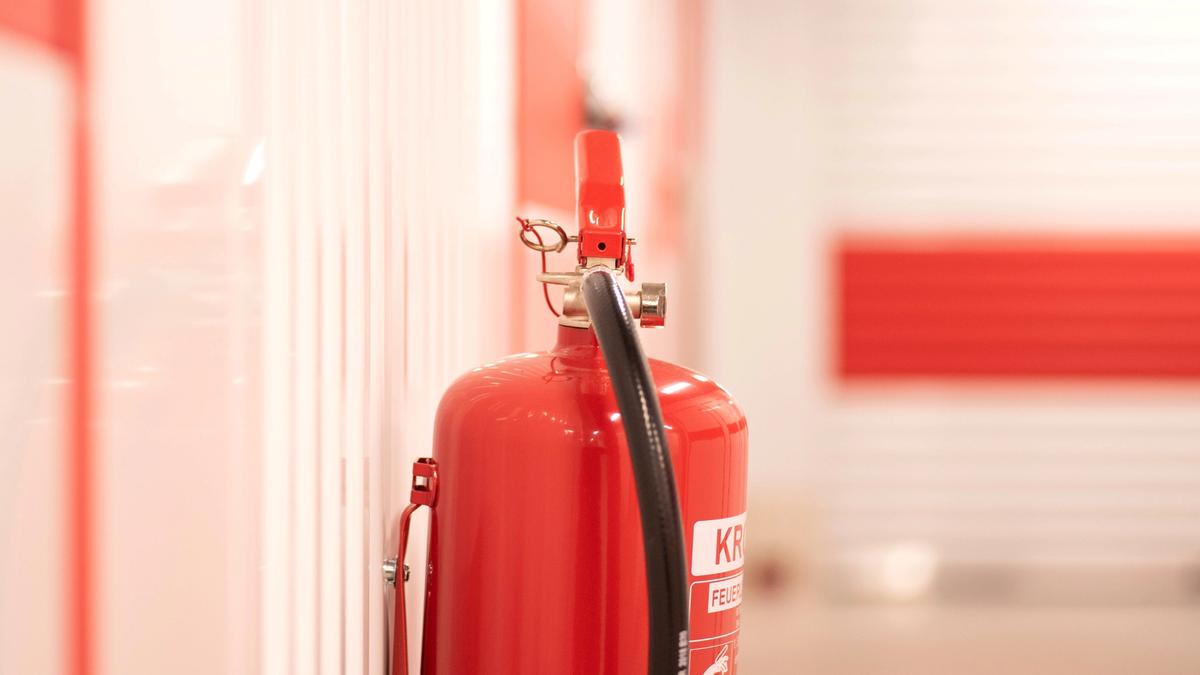What fire safety signs and symbols should you recognize and follow?
In any workplace, hospital, or facility, fire safety signs are more than decoration. They guide action under stress, speed up evacuations, and keep people safe.
At Embracive EHS Solutions LLC, our fire safety course ensures you know the signs, symbols, and colours — so you respond correctly when every second counts.
This article explains the most important fire safety signs, the categories they fall under, the standards behind them, how to spot them in real environments, and why compliance matters.
What are Fire Safety Signs and Symbols
Fire safety signs and symbols are visual markers that inform people about fire risks, escape routes, safety procedures, and fire‑equipment locations.
They serve three main purposes:
- Alerting people to dangers (e.g. flammable materials, fire hazards).
- Guiding people to safe exits or first aid.
- Instructing what action to take (e.g. use fire extinguisher, keep fire door shut).
Legal and standard frameworks: ISO, BS, UK regulations
Fire safety signage must comply with standards to ensure universal understanding. The main ones are:
- ISO 7010: defines graphical symbols, colours, shapes for safety signs globally.
- ISO 3864‑1: design principles for safety signs and safety colours.
- BS 5499 (British Standard): prior standard in UK for safety signs—including fire safety signage.
- Health and Safety (Safety Signs and Signals) Regulations 1996 (UK): requiring safety signs where risks cannot be avoided, and ensuring signs use standard symbols or pictograms.
If your workplace is outside UK, you must check local fire safety legislation. But these standards are widely used or referenced globally.
Key Categories of Fire Safety Signs
Here are the main categories you should know. They differ by colour, shape, and purpose.
Prohibition Signs
- Use: Indicate actions that must not be taken (e.g. “No Smoking”, “No Open Flames”).
- Shape & colour: Usually a circular red band with a diagonal slash (red circle, white background, black symbol).
- Importance: Prevent ignition of fire; especially critical in areas with flammable materials or oxygen supply.
Warning Signs
- Use: Alert people to hazards (e.g. risk of fire, hot surfaces, flammable chemicals).
- Shape & colour: Typically triangular with yellow background and black pictogram.
Mandatory Signs
- Use: Direct actions people must follow (e.g. “Fire Door Keep Shut”, “Wear fire‑safety PPE”).
- Shape & colour: Blue circle with white symbol or text.
Safe Condition / Escape Route Signs
- Use: Show routes to safety, exits, first aid, assembly points.
- Shape & colour: Green rectangle or square with white pictogram; often with directional arrows.
Fire Equipment Signs
- Use: Identify locations of fire‑fighting equipment like extinguishers, hoses, alarms.
- Shape & colour: Usually red with white pictogram/text.
Colours, Shapes and Design Principles
Knowing not just which signs, but how they look, ensures recognition when it matters.
Standard colours & shapes
- Red: prohibition or fire‑equipment signs.
- Green: safe condition / escape.
- Blue: mandatory actions.
- Yellow (or amber): warnings.
Shapes typically match these patterns (e.g. circles for mandatory/prohibition, triangles for warning, rectangles/squares for safe condition).
ISO and BS standards mandate these so signs are consistent.
Pictograms vs text vs arrows
- Pictograms help overcome language barriers and stress conditions.
- Text can augment, but overreliance on text alone slows recognition.
- Arrows are essential on escape route signs to show direction clearly.
Visibility, durability, photoluminescent features
- Signs must be visible under all lighting conditions; glow‑in‑the‑dark (photoluminescent) features are helpful for power failures or smoke.
- Materials must resist fading, damage, moisture.
- Position: height, angle, unobstructed view all matter.
Recognising and Following Fire Safety Signs in Practice
Knowing the signs is one thing; applying them correctly is another.
Placement (escape routes, risk areas)
- Exit signs should mark every change of direction along evacuation paths.
- Fire equipment signs placed at the point of use; extinguishers, fire alarm call points etc.
- Prohibition signs in zones where actions are restricted (e.g. no smoking).
Training and drills: what employees should know
- All staff should be familiar with signs and symbols in their workplace.
- Regular fire drills reinforce habit: see sign, know what action.
- Embracive EHS Solutions LLC’s courses include real examples so people recognise signs under pressure.
Common mistakes / what many get wrong
- Using old or non‑standard symbols that confuse.
- Signs hidden by clutter or poor lighting.
- Text‑only signs when pictograms are required or more effective.
- Failing to maintain photoluminescent or illuminated signs.
Why Compliance Matters for Organisations
- Legal responsibility: Regulations often mandate appropriate signage. Non‑compliance can incur fines or sanctions.
- Safety outcomes: Clear signage reduces confusion during emergencies, which can reduce injuries, fatalities, damage.
- Reputation and insurance: Demonstrating compliance helps with insurance claims, inspections, audits.
How Embracive EHS Solutions LLC can help
Embracive EHS Solutions LLC offers a comprehensive Fire Safety Course (see our Fire Safety training offerings page) that covers:
- Recognition of all major fire safety signs and symbols
- Standards compliance (ISO, BS, local laws)
- Practical scenarios: identifying correct signage, correcting common faults
For healthcare environments or other sectors, we can tailor the training to your facility’s layout, risk profile, and staff needs.
FAQs
- What is the difference between ISO 7010 and BS 5499?
ISO 7010 is the international standard specifying safety symbols, colours and shapes. BS 5499 is a British Standard that was widely used; many UK fire safety signs conform to or align with BS 5499 and ISO. BS standards may still be referenced locally.
- Must all signs use symbols, or can text suffice?
Symbols are best for quick recognition. Text can be supplementary, particularly in multilingual or local contexts. But many regulations (e.g. ISO 7010\) require pictograms for core signs.
- Where should fire exit signs be placed?
Along every escape route; at changes of direction; above doors; clearly visible from far away. They must not be obscured.
- Do signs need to glow in the dark?
Yes, in many workplaces photoluminescent or illuminated signs are required so routes remain visible during power failure or smoke.
- Who is responsible for maintaining fire safety signs?
Usually the employer, owner, or facility manager. They must inspect, clean or replace signs as needed to ensure visibility and compliance.
- What standards apply in India / other countries?
Many countries adopt ISO 7010 or adapt similar standards. In India, there are local safety laws and fire codes; always check local regulations.
- What happens if signage is not compliant?
Risk of legal penalties; increased risk of injury or death in fire; could affect insurance; audits or inspections may fail; liability in case of accident.

